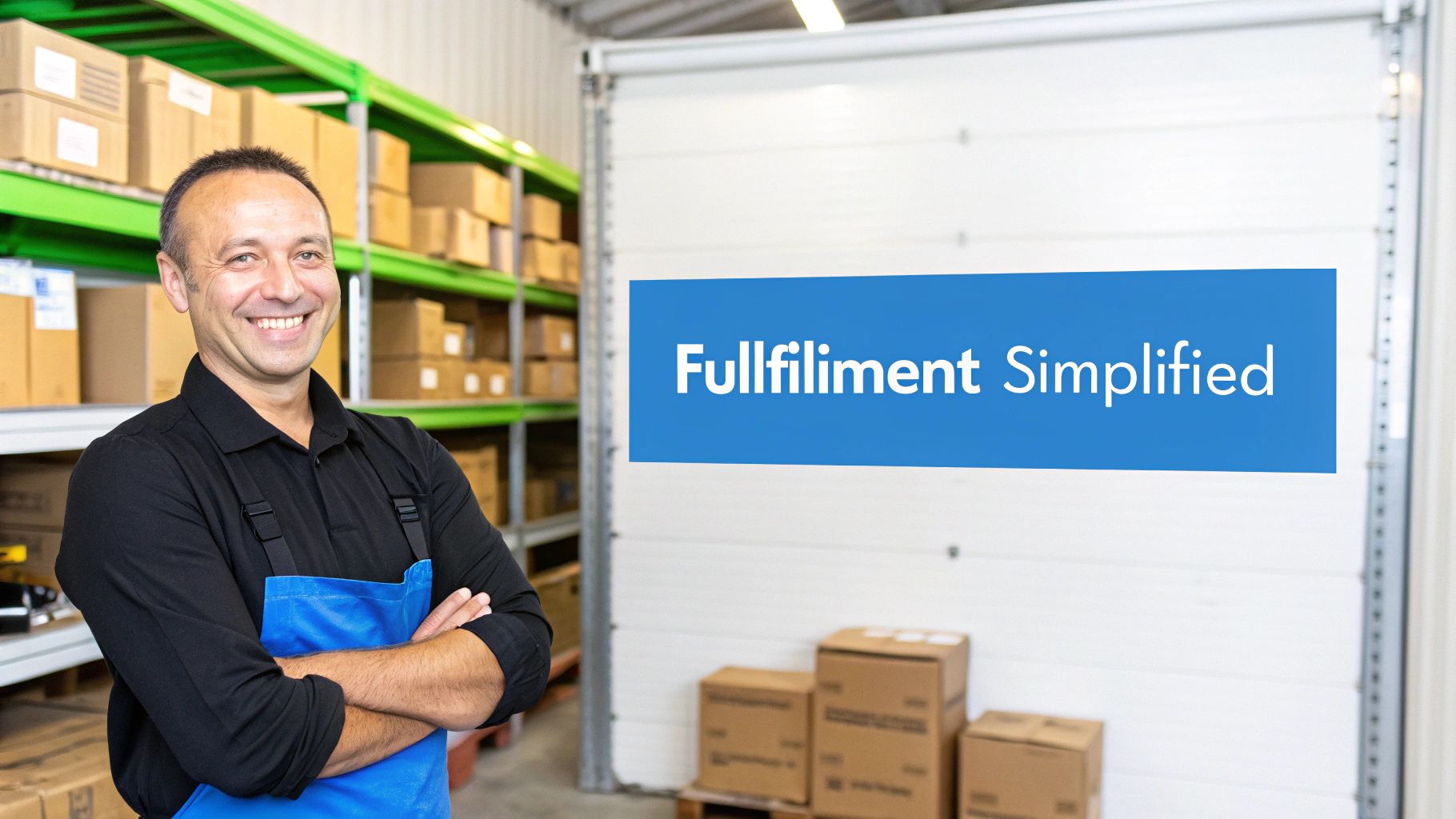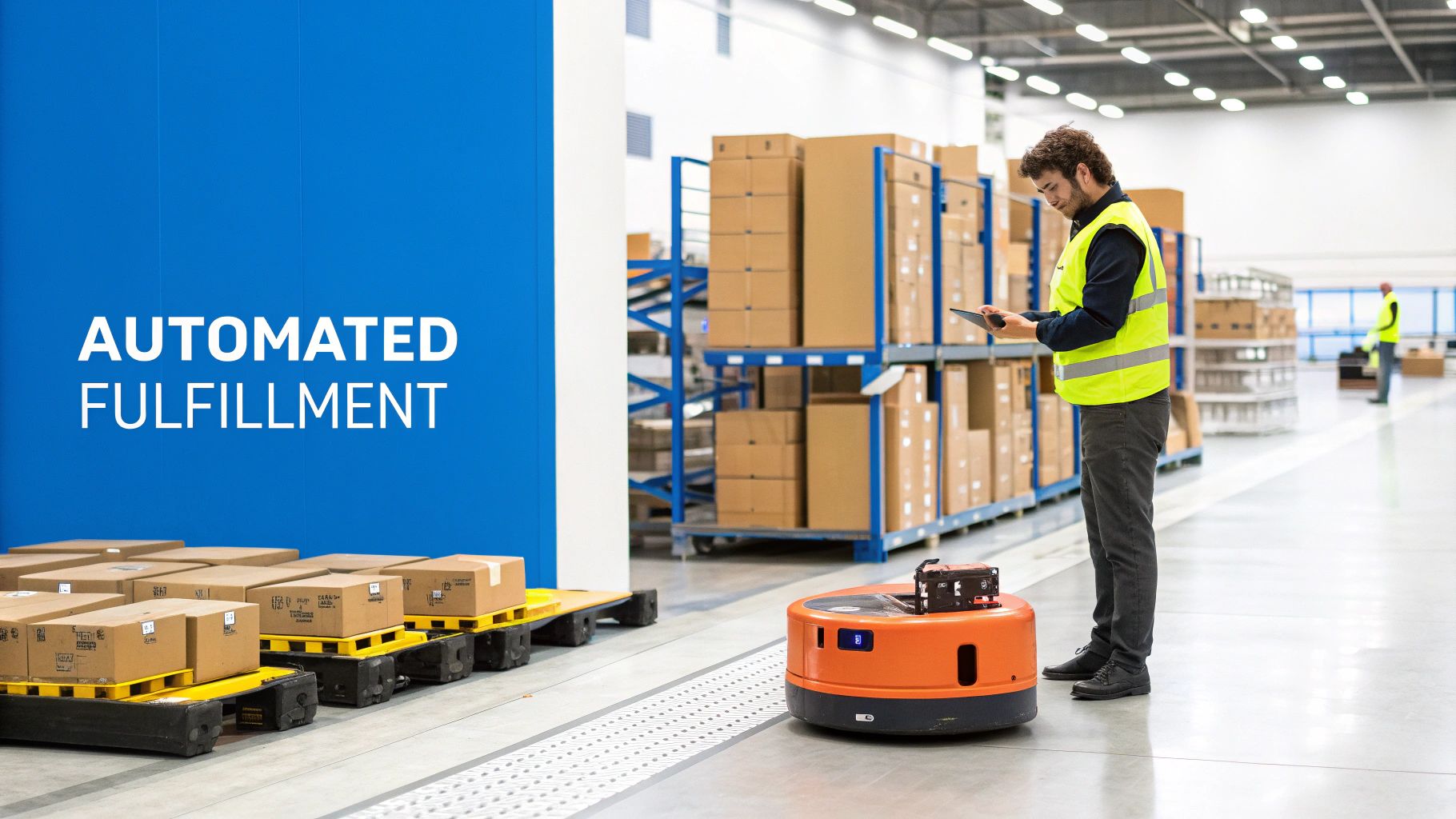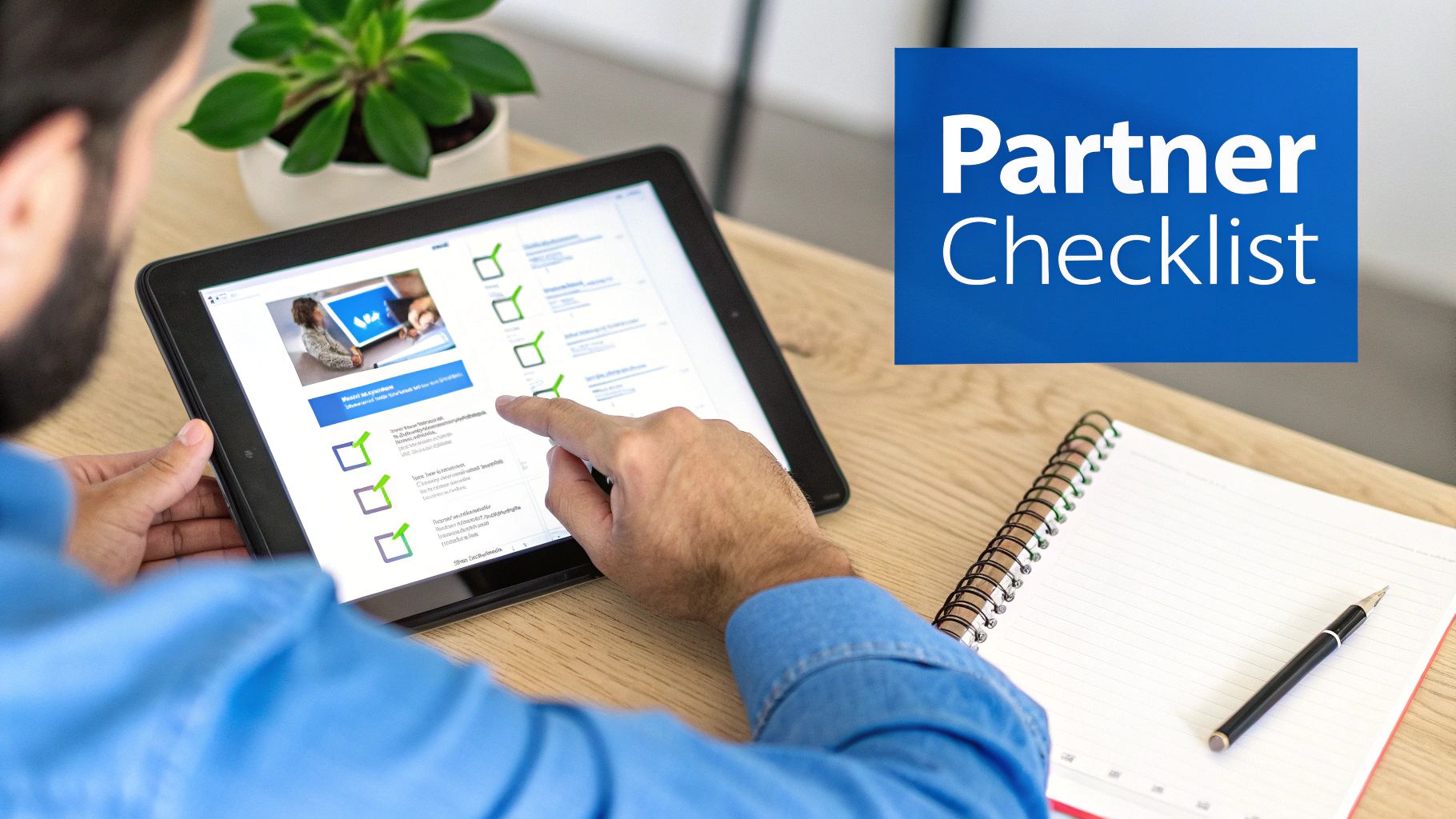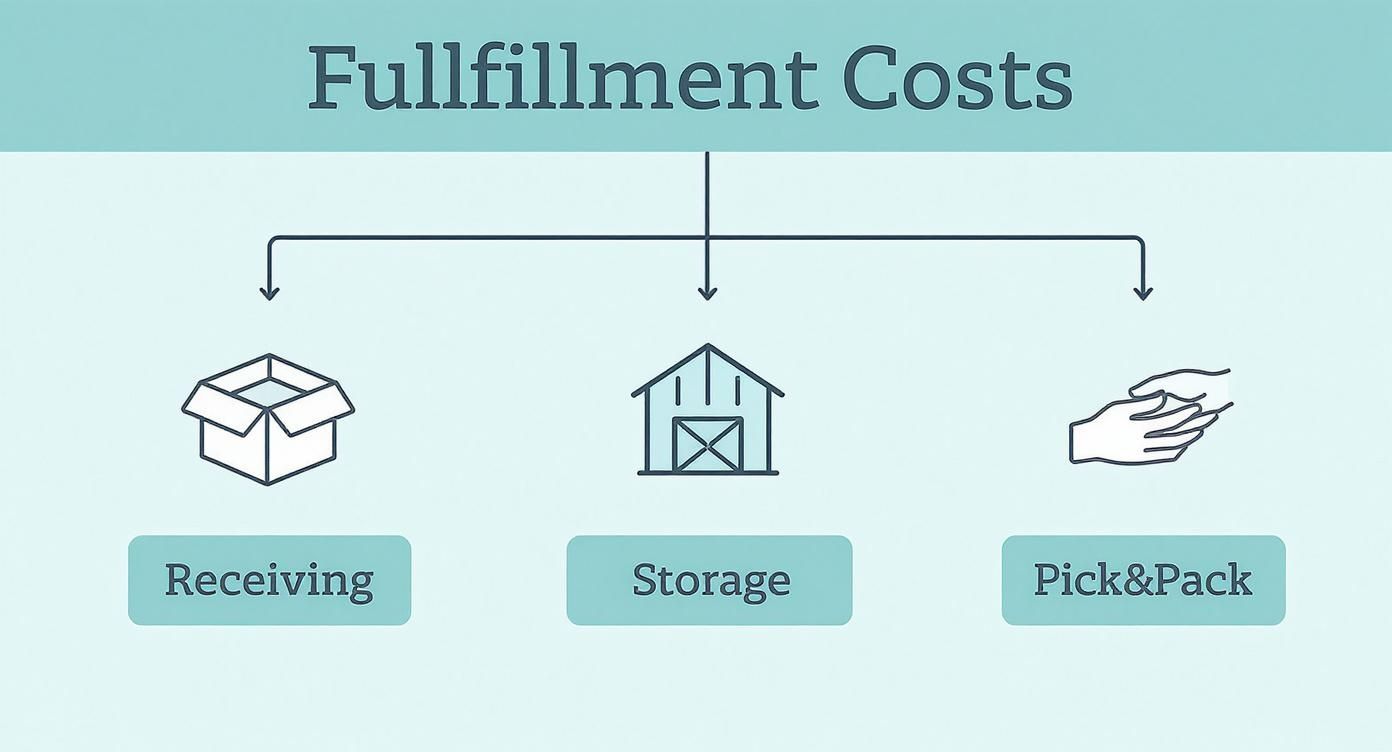Think of a Shopify fulfillment service as your expert, off-site operations team. They step in to handle all the physical stuff—receiving your inventory, storing it safely, and then picking, packing, and shipping orders straight to your customers. It’s a partnership that lets you stop worrying about boxes and tape and start focusing on growth.

Is your garage overflowing with products? Are you spending more time printing labels and wrestling with packing tape than you are marketing your brand? This is a classic growing pain for successful store owners, and it's the exact problem a Shopify fulfillment service solves.
These services, often called third-party logistics (3PL) providers, take the entire physical side of your business off your plate.
You can think of it like this: you make the sale, and your fulfillment partner handles everything that comes next. They've got the warehouse space, the trained staff, and the shipping know-how. When a customer clicks "buy" on your Shopify store, that order gets zapped over to your 3PL. Their team then grabs the right items from your inventory, packs them up, and gets the package on its way.
This isn't just about outsourcing labor; it's a fundamental shift in how you run your business. Instead of getting bogged down in the daily logistics, you can pour that energy back into the things that actually move the needle.
A fulfillment service takes over all these key tasks:
The need for this is massive. Shopify's ecosystem is home to over 4.82 million stores, which collectively processed an average of 199 million orders every single month in 2023. Those numbers show just how huge the operational demand is—and it’s exactly what professional fulfillment services are built for.
The right partner becomes a powerful tool for growth, not just another line item on your expense sheet. By handing your logistics over to the experts, you get access to efficiency and technology that would be incredibly expensive to build on your own.
While most store owners start out shipping orders themselves, understanding the different ways to fulfill Shopify orders becomes critical as your business scales.
Making sure your whole Shopify operation runs smoothly is key, and that includes everything from inventory management to order processing. You can explore a variety of tools and apps to help with this by checking out the Top Apps for Shopify Store to Boost Sales & Efficiency. Ultimately, this shift lets you delight customers with faster shipping and a better unboxing experience, turning what was once a headache into a real competitive advantage.

Shopify's answer to the logistics puzzle is its own in-house solution, the Shopify Fulfillment Network (SFN). Think of it as the "easy button" for fulfillment, designed to work flawlessly within the ecosystem you already use every day. It’s not just another warehouse; it's a network powered by smart technology to streamline your entire operation from click to delivery.
The real magic of SFN is its native integration. Because Shopify built it, there are no clunky third-party apps or complex APIs to wrestle with. When an order comes in, it flows directly into the SFN system. All your crucial data—inventory levels, order status, and tracking information—lives right inside your Shopify dashboard. This creates a single source of truth for your business.
This tight-knit connection simplifies everything from inventory forecasting to handling customer service inquiries, making it an incredibly compelling option for merchants who put a premium on simplicity and efficiency.
At its core, SFN is built on a heavy foundation of automation and robotics. This isn't just about moving boxes from A to B faster; it's about achieving surgical precision. By using advanced warehouse technology, SFN is designed to minimize human error, which means fewer mis-picked orders and, ultimately, much happier customers.
The Shopify Fulfillment Network, launched in 2019 with a $1 billion investment, uses this technology to hit a 99.5% order accuracy rate and enables two-day delivery for most U.S. locations. This capability proved essential during the pandemic, when SFN’s shipping volume surged 2.5 times between Q1 and Q4 of 2020.
This level of performance is a major draw for brands trying to compete with the lightning-fast delivery times set by retail giants. Offering two-day shipping can seriously boost conversion rates and build customer loyalty, turning your fulfillment strategy into a powerful marketing tool.
When you partner with SFN, you're getting more than just storage space and shipping labels. You're tapping into a system with several distinct advantages built specifically for Shopify merchants.
For a deeper look at how SFN stacks up against other fulfillment models, our guide on fulfillment by Shopify offers more detailed insights. These features work together to create a powerful and cohesive logistics backbone for your store.
However, SFN isn't the perfect fit for every single business. Its operational footprint is primarily concentrated within the United States and Canada. If you have a large international customer base or are planning a major global expansion, you might find its geographic reach a bit restrictive.
Additionally, SFN is at its best when dealing with a relatively straightforward product catalog. Merchants selling highly customized items, perishable goods, or hazardous materials will likely need a more specialized 3PL partner that can handle their unique requirements. Understanding these boundaries is key to deciding if SFN aligns with your long-term growth strategy or if a more flexible partner is the better move.

Choosing a partner to handle your fulfillment is one of the most critical decisions you'll make for your Shopify store. This isn't just about finding someone to put products in a box; it's about entrusting a huge piece of your customer experience to an outside team. To get it right, you need to look past the sales pitch and zero in on the features that actually fuel growth.
The absolute non-negotiable is a seamless, native Shopify integration. Your fulfillment partner's system should plug directly into your store, creating an invisible, automatic link. When an order comes in, it needs to instantly pop up in their system without you lifting a finger. This completely eliminates manual data entry, slashes the risk of human error, and keeps your inventory levels perfectly synced in real time.
A deep integration is about more than just grabbing orders. A top-tier fulfillment service for Shopify will give you a dashboard where you can see everything at a glance—from inventory check-in and order status all the way to returns processing. Without that visibility, you're just flying blind.
And what about the future? You might only be selling on Shopify today, but where will you be tomorrow? A smart move is to pick a partner who already supports multi-channel fulfillment.
Choosing a partner with solid multi-channel chops means you can scale your sales efforts without having to tear up your logistics foundation and start over.
Your business has its seasons. A great fulfillment partner can handle your slowest months just as smoothly as the chaotic rush of Black Friday. This is scalability. You have to ask potential partners how they handle sudden order spikes. Do they have the staff, the space, and the systems to maintain shipping speeds when you're 10x busier than normal?
A partner that can't scale with you becomes a bottleneck that throttles your growth. Ensure they have a proven track record of supporting brands through high-volume periods without compromising on accuracy or speed.
Just as important is pricing you can actually understand. The last thing you need are surprise fees popping up on your monthly invoice. A trustworthy 3PL will lay out a simple, clear pricing structure that details every possible cost. Our complete guide on evaluating fulfillment partners for your ecommerce business provides a detailed checklist for this process.
Make sure you get a clear breakdown of these key fees:
A partner committed to transparency helps you understand your true total fulfillment cost, which lets you budget accurately and protect your margins. That kind of financial clarity is the bedrock of a healthy, long-term partnership.
Fulfillment pricing can feel like a maze. You're hit with different fees and a bunch of line items that make comparing quotes a real headache. To find the right partner, you have to look past the sales pitch and get a handle on the full financial picture. The real goal is figuring out your total cost of ownership, not just the advertised pick-and-pack fee.
Think of it like a cell phone bill. That main plan might look like a steal, but it's the data overages, surprise activation fees, and taxes that really determine what you pay each month. Fulfillment works the exact same way. A few core charges form the base of your invoice, but a whole host of other, less obvious fees can pile up fast.
Getting a clear-eyed view of these costs is non-negotiable. Hidden fees can absolutely gut your profit margins, turning what seemed like a great deal into a financial sinkhole. Let's break down the most common charges you'll run into.
Every fulfillment service for Shopify is going to have a few foundational costs. These are the non-negotiable fees tied directly to the physical work of storing and handling your products. The names might change a little from one provider to the next, but they all cover the same basic activities.
You can pretty much guarantee you'll see these on every invoice:
Getting a grip on these three core costs is the first step, but it's only half the battle. The real key to financial clarity is digging in and uncovering the variable—and sometimes hidden—fees that don't always get the spotlight in the initial sales quote.
Beyond the big three, a whole range of other charges can show up on your final bill. A truly transparent partner will walk you through these upfront, but you should always make a point to ask about them. These often include things like account management fees, costs for shipping materials like boxes and dunnage, and separate charges for processing customer returns.
For a complete guide on what to look for on an invoice, you can learn more by demystifying 3PL pricing and fulfillment costs in our detailed breakdown.
Some providers also tack on fees for software access or have monthly minimums. This means if your total fulfillment spending doesn't hit a certain dollar amount, you get billed for the difference. Asking pointed questions about every single one of these potential costs is the only way to avoid sticker shock and make sure you choose a partner whose pricing model actually works for your business and order volume.
Deciding to team up with a fulfillment service is a huge step for your business. Let's turn everything you've learned into a practical game plan that takes you from a long list of potential 3PLs to the perfect partner. The first move isn't looking at them—it's looking in the mirror at your own business.
Before you even start Googling, you need a crystal-clear picture of your operation. A 3PL that's a dream for a clothing brand could be a nightmare for a company selling heavy electronics. Get started by mapping out your store's vital statistics.
This internal audit should cover:
With this data, you're building a profile of your ideal partner. This self-assessment is the filter you'll use to evaluate every 3PL, making sure you find one that fits your real-world needs.
Now you can start the search. Look for providers who specialize in businesses like yours—whether that's subscription boxes, apparel, or electronics. Create a shortlist of three to five promising candidates and get on the phone for discovery calls. These initial chats are your chance to get past the marketing fluff on their website.
This is not the time to be shy. You need to ask direct, specific questions to really understand how they operate and if their company culture is a good match for yours. A great partner will be transparent and happy to answer everything.
A fulfillment partner is more than just a vendor; they're an extension of your team and a direct touchpoint for your customers. Their reliability, communication, and culture are just as critical as their per-order fee. A low price means absolutely nothing if they constantly mess up orders and wreck your brand's reputation.
After your calls, you'll start getting proposals and pricing sheets. This is where your new knowledge of fulfillment costs gets put to the test. Scrutinize every single line item, keeping an eye out for those variable and sometimes hidden fees. If a price seems too good to be true, it almost certainly is.
This infographic breaks down the core costs you'll see in the fulfillment process.

While the pick-and-pack fees get all the attention, it's the receiving and storage costs that form the financial foundation of your partnership. Compare quotes side-by-side, ask for clarification on anything that seems fuzzy, and don't be afraid to ask for references from current clients. This careful, methodical approach ensures you choose a partner who will truly help you grow, not just ship your boxes.
Jumping into the world of fulfillment services can feel like a huge step, and it’s totally normal to have a ton of questions. Let's cut through the noise and get you straight answers to the things merchants actually worry about when they think about partnering with a 3PL.
We'll cover the practical stuff so you can feel confident about what's next.
One of the first things every founder asks is, "When is the right time?" How do you know when you've officially outgrown your current setup? The truth is, the signs usually show up long before your shipping station completely implodes.
You’re probably ready for a change when you spend more time wrestling with a tape gun than you do on marketing or product development. Once you’re consistently hitting 5-10 orders per day, you’ve entered the zone where a fulfillment service stops being an expense and starts being a serious growth lever. And if your garage or office is overflowing with boxes? That’s another massive tell-tale sign.
But what if your products aren't just simple, standard-sized boxes? Plenty of Shopify stores sell items that need a little extra TLC, which is a common point of concern. The solution is finding a provider who specializes.
Always, always ask a potential partner for proof of their experience with your specific type of product. Ask for case studies or examples of how they handle items just like yours. A great partner will have proven, battle-tested processes already in place.
Quick Clarification: Don't get fulfillment services mixed up with dropshipping. With a fulfillment service, you own your inventory. You buy it from your manufacturer and then store it at the 3PL's warehouse. In dropshipping, you never even see the product—the manufacturer ships it directly to your customer. Fulfillment gives you way more control over branding and the customer experience.
Returns are just a part of doing business in ecommerce. But how does that work when you’re not the one getting the packages back? This process has a fancy name—reverse logistics—and it's a standard feature for any top-tier fulfillment service.
When a customer needs to make a return, the package goes straight back to the fulfillment center, not to your doorstep. The 3PL's team takes it from there, following your exact instructions. They'll inspect the item and either restock it into your sellable inventory, set it aside for you to review, or dispose of it. The entire workflow is tracked in the 3PL’s software, which syncs with Shopify to keep your inventory counts perfectly accurate.
Of course, smooth fulfillment starts with solid orders. It's worth learning more about identifying and managing high-risk orders on Shopify to cut down on potential headaches and losses from the get-go. A clean order process makes every single step that follows, including returns, that much easier.
At Simpl Fulfillment, we provide the clarity and expertise you need to scale confidently. From specialized handling to seamless returns, our end-to-end service is designed to support your growth. Learn how Simpl can become the operational backbone of your Shopify store.